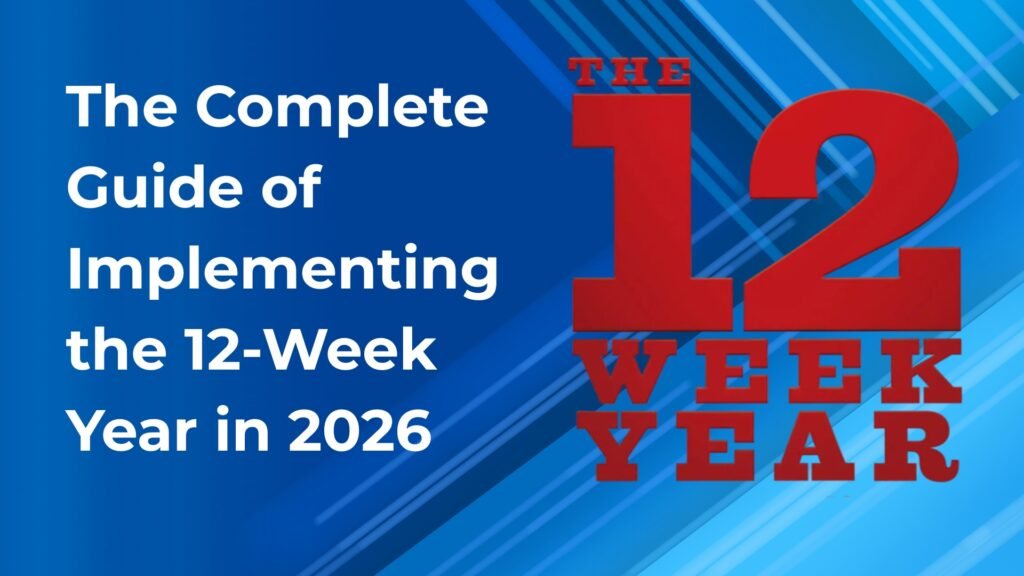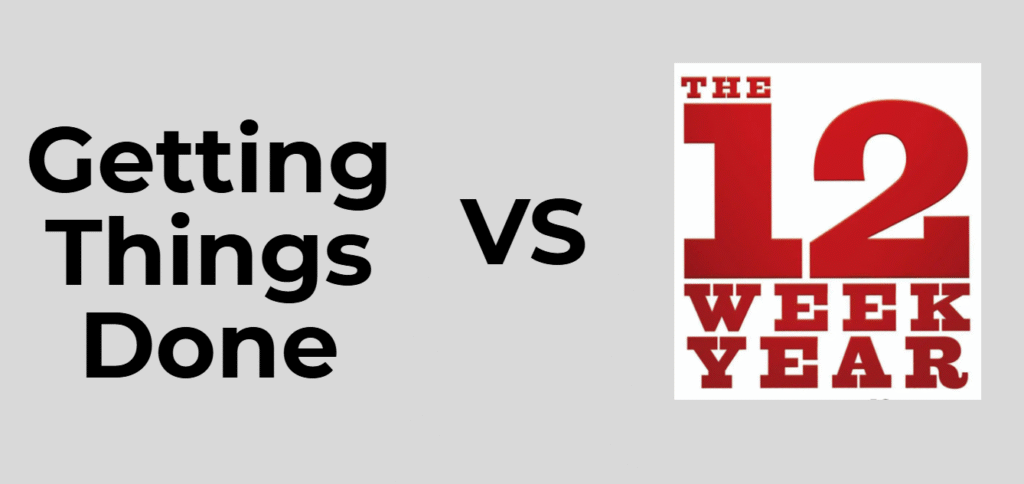
Nov. 5th, 2025


The 12-Week Year wins for rapid execution and accountability. It breaks goals into 12-week sprints with weekly scorecards, creating urgency and measurable progress. GTD wins for comprehensive task organization and reducing mental clutter. Choose the 12-Week Year if you need motivation and short-term focus; choose GTD if you prefer detailed task management and long-term clarity. Many professionals successfully combine both systems.
Written by Dan Mintz, a leading productivity strategist, expert in the 12 week year, and the founder of the 12-Week Breakthrough Program. Wharton MBA, MIT Data Scientist, 3x Entrepreneur.
Worked with dozens of people to transform their lives in 12 weeks.
In 2026, two productivity giants, the 12-Week Year and Getting Things Done (GTD), are set to clash in the quest for optimal efficiency. Each system offers unique frameworks designed to help professionals maximize their productivity, but they approach the challenge from different angles.
The 12-Week Year emphasizes rapid execution and focused actions, urging users to prioritize short-term goals to bridge the “execution gap” that often hinders progress. This method is especially beneficial for those who thrive on motivation and clear metrics, like weekly scorecards, which can make tracking progress feel more tangible. In contrast, GTD encourages a more comprehensive organization of tasks, aiming to capture every commitment to reduce mental clutter.
As you explore these systems, consider how each aligns with your personal style and goals. The effectiveness of one over the other may hinge on your specific needs—whether you prefer a time-bound, action-oriented approach or a more detailed task management system.
In 2026, understanding the differences between the 12-Week Year and GTD is essential for anyone looking to enhance their productivity. As professionals increasingly seek efficient ways to manage their time, the choice of a system can significantly impact performance.
The 12-Week Year’s approach resonates with those who thrive on motivation and measurable progress. Meanwhile, GTD’s detailed task management appeals to individuals who prefer a more structured organization of their commitments. Knowing which system aligns with your personal style can lead to transformative results in both your professional and personal life.
Ultimately, the right choice can mean the difference between stagnation and remarkable growth. As we move forward, evaluating these systems will empower you to make informed decisions and maximize your productivity journey.
Understanding the Capture-Organize-Execute framework is essential to grasping how GTD operates. At its core, this system emphasizes a structured approach to productivity, starting with capturing all tasks and commitments. By getting everything out of your head and into a reliable system, GTD helps you reduce mental clutter and focus on what truly matters.
Once you’ve captured your tasks, the organizing phase begins. Here, you categorize and prioritize your commitments, ensuring that nothing slips through the cracks. Finally, execution is about taking actionable steps based on your organized tasks. Regularly reviewing your progress allows you to adjust as needed, keeping you on track to meet your goals (David Allen’s GTD Official Site).
This holistic approach can be especially appealing for those who thrive on structure and clarity, making it a strong contender against the 12-Week Year. Understanding these components can help you identify if GTD aligns better with your productivity style.
GTD is built on key principles that focus on enhancing clarity and reducing overwhelm. At its core, the system encourages capturing every task and commitment, which helps declutter your mind and streamline your focus. By organizing these tasks into actionable categories, GTD allows you to see your priorities clearly, making it easier to take meaningful steps toward your goals.
Another essential principle is the regular review process. This ensures that you stay aligned with your commitments and can adjust your plans as needed. By consistently evaluating your progress, you maintain momentum and adapt to any changes in your priorities or circumstances. This structured approach can significantly enhance productivity for those who thrive on organization and clarity.
The Weekly Review Challenge is a crucial element in both the 12-Week Year and GTD systems, but they approach it differently. In the 12-Week Year, the weekly review focuses on assessing progress towards your short-term goals. This process encourages you to reflect on what worked, what didn’t, and how you can adjust your actions for the upcoming week. This regular check-in helps maintain motivation and fosters a proactive mindset.
In contrast, GTD’s weekly review is more comprehensive, designed to ensure that every task and commitment is accounted for. You revisit your entire system, organizing tasks and clarifying priorities, which can feel like an exhaustive yet necessary ritual. While both systems value the weekly review, the 12-Week Year emphasizes immediate action and motivation, while GTD leans towards detailed organization and clarity. Choosing the right approach depends on your personal productivity style and what resonates most with you.

The 12-Week Year revolutionizes productivity by breaking the year into manageable, focused periods. This method encourages individuals to prioritize actionable goals, allowing for quicker assessments of progress and more immediate feedback. By concentrating on short-term objectives, users can maintain enthusiasm and direction, making it easier to adapt strategies as needed.
In contrast to traditional annual planning, this system has proven effective for many professionals, especially those who benefit from rapid execution. For instance, sales teams adopting the 12-Week Year have reported significant improvements, including a noteworthy 35% revenue growth within a year. This demonstrates how periodization can enhance focus and drive, allowing individuals to achieve accelerated results (Weeniecast).
Ultimately, the 12-Week Year empowers users to harness their productivity potential by fostering a mindset geared toward immediate action and tangible outcomes, making it a compelling choice for those seeking to elevate their performance in 2025.
Focused sprints are at the heart of the 12-Week Year, fostering an environment where productivity thrives. This approach encourages intense bursts of activity aimed at achieving specific goals, allowing individuals to channel their energy and creativity for maximum impact. By concentrating on short-term objectives, users can maintain motivation and see tangible results quickly.
Research indicates that breaking work into focused intervals can significantly enhance concentration and reduce mental fatigue. These sprints create a sense of urgency without the stress of long-term planning, making it easier to stay engaged and committed. The rapid feedback loop inherent in this method helps individuals adjust their strategies promptly, ensuring that they remain on track to meet their goals.
Ultimately, focused sprints not only boost productivity but also cultivate a mindset geared toward achievement, making them a key differentiator for the 12-Week Year in the productivity landscape.
Weekly scorecards serve as a powerful accountability tool within the 12-Week Year framework. By tracking progress weekly, you gain visible insights into what’s working and what needs adjustment. This regular check-in helps maintain focus and motivation, making it easier to stay aligned with your short-term goals.
The scorecards not only highlight achievements but also pinpoint areas for improvement, fostering a proactive mindset. This immediate feedback loop can be particularly motivating, encouraging you to keep pushing forward and make necessary course corrections. As you reflect on your progress, the tangible data empowers you to make informed decisions about your next steps, ensuring you stay on track for your 12-week transformation.
When comparing the 12-Week Year and GTD, it’s clear that their core philosophies set them apart. The 12-Week Year focuses on rapid execution of short-term goals, encouraging users to consistently assess their progress through weekly scorecards. This method cultivates a sense of urgency and motivation, making it easier for individuals to stay on track and adapt quickly when challenges arise.
In contrast, GTD emphasizes comprehensive task management by capturing every commitment to reduce mental clutter. This system’s strength lies in its structured organization and regular reviews, enabling users to maintain clarity and focus. While both systems aim to enhance productivity, the 12-Week Year excels in creating immediate momentum, while GTD provides a detailed framework for long-term organization and clarity in task management (Lorin Creative).
The time horizon and planning scope of the 12-Week Year and GTD are fundamentally different, shaping how users engage with their productivity. The 12-Week Year emphasizes short, actionable periods that allow for quick adjustments and results. This method encourages professionals to set goals within a 12-week framework, leading to a heightened sense of urgency and motivation. With this approach, you can evaluate your performance frequently, ensuring that you stay aligned with your immediate objectives.
In contrast, GTD operates on a more expansive time horizon. It focuses on capturing and organizing all tasks and commitments, which can sometimes lead to feeling overwhelmed by the breadth of responsibilities. GTD encourages a comprehensive view of productivity, where long-term projects and goals are meticulously managed over time. This allows for deep clarity but may lack the immediate momentum that the 12-Week Year cultivates. Each system offers unique strengths, making the choice dependent on your personal productivity preferences.
When it comes to execution philosophy, the 12-Week Year thrives on a dynamic approach that prioritizes short-term goals and rapid feedback. This system encourages professionals to break their year into 12-week cycles, fostering a sense of urgency that propels action. By focusing on immediate results, users can adapt strategies in real-time, maintaining motivation and ensuring alignment with their objectives.
In contrast, GTD’s execution philosophy revolves around thorough organization and clarity, allowing individuals to manage a broader range of tasks and commitments. This method emphasizes capturing everything in a reliable system, which can feel overwhelming at times but serves to reduce mental clutter. Execution in GTD is systematic, requiring regular reviews to keep tasks aligned with longer-term goals, which can be beneficial for those who prefer a structured approach.
Ultimately, the choice between these philosophies hinges on your personal productivity style. If you thrive on immediate results and quick adjustments, the 12-Week Year may resonate more with you. However, if you prefer a detailed framework that keeps all commitments organized, GTD could be your go-to strategy.
In both the 12-Week Year and GTD systems, measurement and feedback loops play crucial roles in driving productivity. The 12-Week Year emphasizes immediate feedback through weekly scorecards, allowing users to track their progress and make necessary adjustments quickly. This approach fosters a sense of urgency and motivation, empowering individuals to remain focused on their short-term goals.
On the other hand, GTD relies on regular reviews to assess and refine task organization. This structured reflection helps users maintain clarity and ensures that all commitments are aligned with their overall objectives. While GTD’s methodical reviews can create a comprehensive overview of tasks, the 12-Week Year’s emphasis on swift feedback may resonate better with those seeking rapid results and continuous motivation. Each system’s measurement approach reflects its core philosophy, ultimately guiding users toward enhanced productivity.
The complexity and learning curve of the 12-Week Year and GTD can greatly influence which system you choose. The 12-Week Year, while straightforward, requires a shift in mindset towards short-term goal setting and rapid execution. This transition can be invigorating for some, as it fosters a culture of accountability and measurable progress. However, it may take time for users to adapt to the rhythm of 12-week cycles and embrace the urgency they bring.
On the other hand, GTD’s comprehensive framework involves a steep learning curve. Capturing and organizing every task can feel overwhelming initially, especially for those used to less structured approaches. However, once the system is mastered, its clarity and organization can lead to a sense of relief and enhanced productivity. Ultimately, your choice may depend on how comfortable you are with each system’s demands and how quickly you can adapt to its methodology.
Implementing either the 12-Week Year or GTD requires a clear understanding of your personal productivity style and goals. The 12-Week Year thrives on setting short, actionable objectives that drive motivation and accountability. By focusing on 12-week cycles, you can regularly assess your progress, making it easier to adapt strategies and maintain momentum throughout the year.
On the other hand, GTD offers a structured method for capturing and organizing tasks, which can enhance clarity and reduce overwhelm. This system emphasizes a comprehensive overview of commitments, encouraging regular reviews to keep everything aligned. While it may take time to master, the clarity it provides can lead to long-term productivity gains. Ultimately, choosing the right system hinges on whether you prefer rapid execution or detailed organization in your productivity journey (The 12 Week Year Official Website).
To effectively implement the GTD system, start with the crucial step of capturing all tasks, thoughts, and commitments. Use a reliable tool, whether it’s a digital app or a physical notebook, to ensure nothing slips through the cracks. This initial phase is essential for reducing mental clutter and setting a solid foundation for your productivity journey.
Next, focus on organizing your captured tasks into clear categories, such as projects, next actions, and waiting for items. This structured approach will help you prioritize effectively, making it easier to identify what needs immediate attention. Regularly review your organized tasks to maintain clarity and momentum, adapting your plan as necessary to align with changing priorities.
Finally, commit to a consistent execution routine. Break your tasks into actionable steps, and utilize the weekly review to assess your progress and refine your approach. This cyclical process not only keeps you aligned with your goals but also fosters a sense of accomplishment as you check items off your list. By diligently following this roadmap, you can master GTD and elevate your productivity to new heights.
Implementing the 12-Week Year requires a structured approach that begins with defining your key objectives. Start by identifying 2-3 primary goals you want to achieve in the upcoming 12-week period. Break these down into actionable steps and prioritize them based on urgency and importance.
Next, establish a weekly routine that includes setting aside time for reflection and assessment. Use weekly scorecards to track your progress, noting what worked and what didn’t. This feedback loop keeps you accountable and allows for real-time adjustments, ensuring you remain on track to meet your goals.
Finally, commit to constant engagement with your plan. Regularly revisit your objectives, adapt your strategies, and celebrate small wins. This dynamic approach not only fosters motivation but also cultivates a habit of accountability that can lead to significant productivity gains.
The choice between the 12-Week Year and GTD ultimately depends on your individual productivity style and needs. The 12-Week Year caters to those who thrive on short-term goals, immediate feedback, and the motivation that comes from rapid execution. If you find that quarterly focus helps you stay accountable and energized, this system might be the perfect fit for you.
On the other hand, if you prefer a comprehensive approach that captures every task, GTD offers a structured method for reducing mental clutter and maintaining clarity. This system is ideal for individuals who appreciate detailed organization and long-term planning. In the end, evaluating how each system aligns with your personal goals can lead to significant improvements in your productivity journey (r/productivity).
The 12-Week Year focuses on short-term, actionable goals, while GTD emphasizes comprehensive task organization. The former uses metrics for tracking, whereas the latter aims to declutter your mental space by capturing all commitments.
The 12-Week Year is ideal for individuals who thrive on motivation and require clear, short-term goals. It’s particularly beneficial for those looking to bridge the execution gap and enhance accountability through weekly scorecards.
Yes, many professionals successfully integrate both systems. You can use GTD for task organization while applying the 12-Week Year for setting and tracking short-term goals, blending comprehensive management with focused execution.
By breaking the year into 12-week cycles, the 12-Week Year creates urgency and clarity, encouraging users to prioritize their most important tasks. This structured approach helps reduce distractions and enhances overall productivity.
Absolutely! GTD excels in managing long-term projects by capturing all tasks and commitments, ensuring nothing falls through the cracks. Its system allows for ongoing review and adjustment, making it suitable for complex, extended timelines.

Dan Mintz is the creator of the 12 Week Breakthrough Program. He advised dozens of individuals on how to achieve their most ambitious goals and reach their full potential.
Dan can be reached at:
dan.mintz@12week-breakthrough.com
About Dan Mintz
Additional Links:
Join the Program
Our Blog Page
Amazing Productivity Blogger
Social Links:
LinkedIn
X / Twitter
Instagram